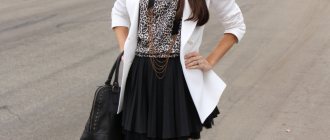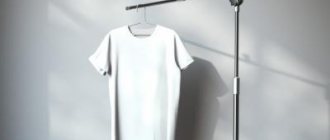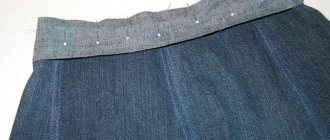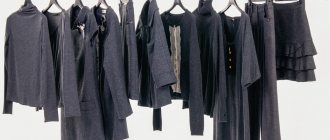Modern fashionistas value versatile clothing items that are suitable for any body type and look feminine and stylish. Many craftswomen prefer to create exclusive things with their own hands. And then the question arises: how to sew a circle skirt quickly, but efficiently. Flared models have been popular at all times, in contrast to tapered and straight products, which are not suitable for everyone. Such skirts add a touch of mischief and girlish exuberance to even the most formal looks.
Varieties of style
A circle or full sun skirt is an elegant style that fits tightly around the waist, upper hips, and then falls in smooth folds. When sewing, wedges are used: narrow at the top and wide at the bottom; There are also models without seams. When unfolded, the skirt is a circle with a hole in the central part, equal to the waist circumference.
Half-sun is a less flared skirt model, for sewing which a pattern in the form of a half circle is used. The style first appeared in eastern countries and gained enormous popularity in India. In Europe, the model is usually called a bell because of its external resemblance to a charming spring flower.
The ¾ circle skirt is less spacious. Its front and back are equal to three-quarters of a circle. The skirt does not widen as much at the bottom and forms fewer folds. The product can be of any length, looks elegant and feminine.
There is another option - quarter skirts. The style is narrower, does not have pomp and volume. The product represents a fourth part of a full circle.
Sun
half sun
Skater skirt ¾ Quarter sun
Flare
Skirts are classified by length. There are three options in total:
- Mini. Helps showcase slender legs and draw attention to the hip line. A short skirt is suitable for discos, parties, and everyday use.
- Midi. A universal option, suitable for almost all women. The style of the skirt masks imperfections on the hips and is optimal for creating casual and office looks.
- Maxi. Long skirts are made from various fabrics: thick - for business looks, flowing - for summer, noble - for evening. Floral prints and checkered patterns are trending.
Skirt models are complemented by an internal lining to add fullness. This allows you to correct a seductive silhouette even with a lack of volume in the hips. To achieve a similar effect, you need to select a length that covers your calves.
The flared sun skirt has a universal cut. Looks attractive on a variety of representatives of the fair sex, regardless of height and build.
Mini Midi
Maxi
https://youtu.be/tD-8osuJM3s
What fabric to make a sun skirt from
In fact, the circle skirt is a full-fledged circular style, the diagram is a circle with a hole in the middle. Due to this, she looks lush. It requires a large amount of fabric. If you choose a dense one, the product will seem heavy. Therefore, for this style it is recommended to take thin, weightless materials. They look nice and easy. If you still need to sew from thick fabric, then it is better to take a shorter length of the product itself, so as not to create unnecessary weight.
Chiffon skirt "sun"
“Sun” made of thin fabric, for example, chiffon, looks very beautiful due to its impressively falling folds and does not hold volume. But in strong winds it does not hold up and can rise too high. Thick fabric, even without movement, looks fluffy, but confidently holds its shape.
For such a product, thin silk or cotton fabric is ideal, which will fall beautifully, or suit fabric, but not very dense, but loose, so that folds form.
Choice of material and color
The textiles used to create skirts must be resistant to wear and fading under the sun's rays. The most comfortable to wear will be models made of breathable materials. Summer skirts are made from flowing fabrics: silk or satin. For the cold season, dense options are preferred: wool, corduroy, velvet.
Cotton fabric is perfect for sewing a circle skirt for the summer. It has a pleasant tactile sensation and allows air to pass freely.
You can make a single-layer or multi-layer skirt with your own hands. In the second case, light, airy fabrics are used: chiffon or thin viscose. For the bottom layer of the skirt, coarser materials are selected that can hold their shape: crinoline and others. This model has an elegant, formal look.
Silk Satin
Wool Velvet Velvet
Cotton fabric
Color solutions can be very different: from muted pale tones to light, beige, powdery. Connoisseurs of the classics should pay attention to the strict black color, relevant in any season. If this option seems boring, an excellent alternative would be a shade of sea green, emerald.
The color palette of natural stones is in fashion: coral, turquoise, burgundy, mustard, gray, brown. The warm season is not complete without bright colors: blue, carrot, green. In cold weather, it is recommended to wear skirts decorated in soft blue, milky, orange, and yellow shades.
What fabric are skirts made from?
Absolutely all fabrics are held in high esteem - both natural and with an admixture of synthetics and completely synthetic ones. The most popular fabrics from which skirts are made:
- Natural cotton. This material is almost universal. Thin fabrics are ideal for summer, and thick ones for the cold season. Cotton products breathe well and do not cause discomfort to wear.
- Linen. A material that has long been considered noble. Its ability to allow air to pass through gives the body maximum comfort.
Linen skirt
- Velvet. It is most often used to make holiday clothing because of its specific appearance, but recently stylists have been skillfully incorporating it into everyday looks.
- Jeans. Due to its structure, it successfully emphasizes the figure and hides imperfections. It is because of this that girls with curvaceous figures prefer him. Denim is a universal fabric for both summer and winter.
- Silk. This material is found equally both natural and artificial. Skirts made from it look very festive, and the choice of colors is almost limitless.
Silk option
- Wool (cashmere, tweed, boucle, etc.). Material for cold weather, looks very advantageous. Wool fabric can be of different densities.
- Velveteen. The material, which came into fashion not so long ago, is more suitable for the cold season. It has a specific structure, due to which it looks interesting on any figure.
- Atlas. Smooth fabric that shimmers very effectively. It is very often used on skirts for wedding and evening dresses.
You might be interested in this Description of the properties, characteristics and appearance of guipure fabric in different colors
Satin product
As for the color palette, skirts in indigo, emerald, red, burgundy and, of course, classic black will look win-win.
Taking measurements
To create a skirt pattern, you need to measure individual parameters. To obtain the most accurate data, it is enough to follow simple rules:
- The measurement is carried out using a thick measuring tape. During operation, it should not be tightened or loosened too much.
- The girl from whom measurements are taken should stand straight, at ease, with her usual posture and arms down. In this case, the heels are brought together and the toes are spread apart.
- To prevent clothes from distorting the data, it is recommended to take measurements over the underwear.
- All paired parameters are determined on the right side.
- The permissible error in measurements for a skirt can reach 0.5 cm, but no more.
To calculate the parameters of the future product, you only need two measurements. The waist circumference is measured with a tailor's meter along the line of the narrowest point of the silhouette or at the level where you plan to wear the skirt. The tape is positioned horizontally, tightly surrounding the body, not too loose, but not too tight. The length of the skirt is determined from the side; for this, the meter is applied to the waist line and lowered down. This indicator depends on individual preferences.
How to choose fabric
From the article it is clear that the choice of fabrics for sewing skirts is insanely large. However, for beginners it is better to sew from silk, denim, gabardine - these materials are not picky and fit very well. Velvet, chiffon, and satin may seem difficult. In addition, you should not take fabrics from
Fabric with complex prints
The types of fabrics for skirts are delightful in their abundance, they are limitless - they can be absolutely any and with any composition. The main thing to consider when selecting is that the resulting product should effectively emphasize advantages, hide flaws and correspond to the season of wear. Knowing what fabric you can use to make the skirt you need, you can significantly reduce your search time. Not every sewing school gives such a detailed description.
Creating a pattern
In fact, to sew a circle skirt with your own hands, it is enough to cut a circle from the fabric, in the middle of which there will be another circle - a belt. The main condition is the accurate calculation of their radii. You can make a pattern on a large piece of paper, folded twice. Actions are carried out in stages:
- Two segments equal to the calculated radius are laid out. A right angle is formed, and a small segment for the belt is marked on each side.
- Using a compass, a dotted line of a circle with a calculated radius is drawn.
- Based on the desired length, segments are laid on the sides of the angle, and a new circle is drawn. The radius is measured from the vertex of the right angle.
- The resulting drawing of the front part is cut out. You can mark the edge allowances in advance.
- It is recommended to apply the paper pattern of the circle skirt to the body to identify possible inaccuracies.
Additionally, a rectangular element is cut out to create a belt. Its length is equal to the circumference of the waistline with the addition of seam allowances. The width is determined independently, but we must not forget that it will decrease by 2 times when stitching.
Mark the radius of the small circle, the place for the belt
Connect the resulting points with a dotted circle line
Set aside the lengths of the skirt, draw a new circle Cut out the drawing
Cut out a rectangular belt element
What fabric is better to sew a semi-sun skirt from?
The half-sun has all the same features as the sun, except that according to the design it forms a semicircle, accordingly it has less pomp and less fabric is needed to sew it. Half-sun allows you to expand your choice and choose thick fabrics for the fall, because... the product will not be so heavy.
You may be interested in: What fabrics are used to create children's bedding
Summer skirt
Fabric consumption calculation
To clarify the required amount of material, you need to decide on the features of the future model. In particular, you should decide whether seams will be used, if so, then one or two. After this, you can proceed to calculations.
To create a seamless skirt you will need a square of fabric. The standard width does not exceed 150 cm, so the length is taken exactly the same. Another 1.5 cm is added to the waist measurements for a loose fit. The resulting number is denoted by the letters OT. To calculate the radius of a circle, the formula is used: R = OT/6.28. Approximately 4 cm is left for allowances.
Fabric consumption for a model with two seams is calculated as for 2 half-skirts. The necessary parameters are specified, the same formula is used. So, if the waist circumference is 65 cm, the length is 80 cm, 65/6.28 is 10 cm.
The calculation of the fabric depends on its properties. A surface decorated with prints or floral motifs is always cut in only one direction, regardless of the length of the product. To carry out the calculations, you need to multiply the optimal indicator by 4 and add 4 notch radii and another 4 cm for allowances.
Formula for calculating the radius of a circle
Skirt without seam
With two seams
Fabrics for pencil skirts
The name for the product “pencil” has always been considered a basic model in the wardrobe. Absolutely any fabric is perfect for it. Most often, of course, costume ones are used. Such a skirt must keep its shape and not wrinkle, so it is better not to use 100% natural fabric.
The following compositions work well:
- Wool + elastane.
- Wool + lavsan + elastane.
- Wool + viscose + elastane.
For the warm season, linen, knitwear or jeans are good. In cold weather - tweed, drape, corduroy complemented by lining.
Wool + elastane
The fabric for a straight skirt is no different from the choice for a pencil skirt. There can be literally any options, the main thing is to choose wisely for the season. It would be nice if the composition contains stretch.
Uncover
To transfer the product to the material, you need to bend the fabric in half, across the warp threads. The circle skirt pattern on the fabric is placed on top and secured with pins so that the diameter falls on the fold line. If the allowances and waist seams were not marked on the drawing, you can immediately apply it to the material; you just need to set aside the required piece of paper.
The length of the allowances when cutting a circle skirt depends on the type of seams that will be used to sew together the elements. It's better to leave a little more than planned. Subsequently, they will help to correct the finished parts if the measurements were carried out with errors.
The element is carefully cut out with scissors while simultaneously capturing all layers of fabric. The result is a round part. If you plan to sew in a zipper, a cut is made on one side of the product along the fold line.
Recommendations for clothing design include trying on the model after cutting. A mannequin will be an excellent assistant in this work. The product is placed on it to detect possible deformations.
The circle skirt pattern is attached to the product that has sagged for comparison. If necessary, the edges are trimmed with sharp scissors.
Fold the fabric twice
Set aside the radii of the circles along the pattern
Mark seam allowances Cut out piece
How to care for “sun” and “half-sun” skirts?
- It is recommended to iron all skirt items from the wrong side. Lush models and those with folds are best ironed with a special steamer in a vertical position.
- Such products should only be stored on hangers, but not on cabinet shelves.
- When it comes to washing skirts, it is best to wash them by hand. This is especially true for materials such as jacquard, wool and silk.
- Products made from synthetic textiles can be washed in a washing machine using the “gentle” setting.
Sewing instructions
Detailed master classes with photographs and stages of work will help you figure out how to sew a circle skirt. You can create a variety of models with your own hands: with an elastic band, with a zipper, a belt. The floor-length options look interesting, and even novice seamstresses can make them.
Simple model with elastic band
The elementary version of the skirt is optimal for beginners. To do this, you need to cut out the main element, but without the belt. There is no back seam cut, and the seam allowance at the top of the seam is 4cm larger than usual. This is necessary for sewing elastic into the skirt. Further actions are performed step by step:
- The elastic is measured according to the waist circumference. When trying on, you should hold it a little tight so that the finished product is held securely.
- An elastic band is placed at the top edge of the skirt, the fabric is slightly gathered and basted by hand.
- The skirt is being tried on. If there are no problems, the elastic is sewn on a machine.
- The bottom edges are folded twice. First - by 5 mm, then - by 10, each layer is carefully ironed, then stitched.
When creating a circle skirt from knitwear or very thin fabric, special edge processing will be required. The best option would be a small zigzag stitch. The easiest way to do it is with an overlocker.
If you are planning a circle skirt for a girl, the elastic option is ideal. It is practical, does not restrict movement, and is comfortable to wear.
Cut out the fabric
Cut the elastic to the desired length
Hand baste the elastic, gathering the fabric
Try on the skirt, sew on the elastic using a machine Fold the bottom edge twice, iron and sew
Ready-made skirt with elastic
With zipper
A classic example is used to construct a circle skirt pattern and cut it out. Stitching is carried out according to the instructions:
- An adhesive tape is attached to the belt blank: along the entire length and half the width.
- The tape is fixed using an iron. It is best to iron through a waste piece of cotton. The belt is folded in half, the sections are joined and carefully ironed.
- The section of the belt is sewn together, then the middle seam is connected at the back of the product, leaving space on top for a zipper.
- A belt is sewn to the top of the skirt so that it extends from one edge to the other.
- The clasp is attached. The bottom of the skirt is stitched with tucking, and the cuts are processed.
The skirt with a zipper is turned right side out, all seams and fasteners are ironed. The product is ready. All you have to do is wash the skirt and you can wear it.
Attach adhesive tape
Sew a section of the belt Connect the middle seam at the back of the product, leaving space on top for a zipper Sew on the belt
Fasten the zipper, stitch the bottom of the skirt, iron all seams and clasp
Floor length model
Floor-length circle skirts are considered the most attractive for summer holidays and luxurious evening looks. For example, a long model can reach 96-102 cm with a height of 170 cm. A description of all stages will help you do the work yourself:
- Both halves of the “sun” and the belt are cut out, taking into account allowances.
- The side sections of the skirt along the front side are processed using an overlock machine.
- The right side seam is stitched 1.3 cm from the edge and smoothed with an iron.
- Using an adhesive strip, the belt element is duplicated, the part is folded in half and ironed.
- A long section of the waistband is overlocked using an overlocker, and two lines of large stitches are laid on both sides of the product.
- The skirt waistband is sewn on, all allowances are ironed.
- The hidden zipper is pinned, then sewn on, and the belt is sewn on.
- The bottom is leveled during fitting, then hemmed with a closed cut.
The satin skirt looks luxurious. The noble material emphasizes the curves of the body and falls in beautiful folds. A skirt made of this fabric is an excellent solution for creating an evening look.
Cut out the skirt details
Finish the side edges with an overlocker
Stitch the right side seam 1.3 cm from the edge, iron it
Duplicate the belt element with an adhesive strip Fold in half, iron it Overcast the long section of the belt Place two lines on both sides of the product
Sew on the skirt waistband Iron seam allowances
Pin the zipper with pins Sew the zipper together with the belt Hem the bottom of the skirt
Ready product
With belt
The sun with a belt looks cute and feminine, securely fixed at the waist. To make a model yourself, use step-by-step instructions:
- Elements are cut out from the selected fabric. In one place the main part is cut, then stitched, leaving 10-15 cm.
- The bottom edge is hemmed.
- The belt for the skirt is made from a strip of fabric 10 cm wide. The circumference is equal to the waist circumference.
- The beginning of the belt is stitched, the upper edge of the product is inserted and stitched along the entire length.
- A loop is made for the fastener and a button is sewn on. The hole is cut out with scissors and stitched.
The skirt model with a belt is attractive and comfortable. The lower edges are finished using a narrow seam on the folded edge, or the edges are folded and stitched.
Cut out the elements of the product Cut the main part in one place, sew, leaving 10-15 cm from the top
Hem the bottom edge
Cut out the belt piece
Sew the beginning of the waistband Insert the top edge of the skirt, sew along the entire length Cut out a loop for the fastener, overcast
Sew a button
Features of choice
The sun skirt visually widens the hips. Therefore, despite the versatility of the style, individual characteristics must be taken into account.
For tall, thin girls, a flared skirt can be of any length and color. Folds will create smooth shapes and add femininity.
For girls with an inverted triangle body type, a flare at the bottom will make the silhouette more proportional. Sew flared skirts from soft fabrics that create beautiful tails.
For ladies with developed hips (pear-shaped figure), it is advisable to sew a flared skirt longer - to the knee and below. Otherwise, the flares will only emphasize the already wide hips.
If you have an apple figure, choose flared, high-waisted skirts. She will hide her tummy, making her figure more graceful. For such a figure, it is important to consider what fabric the skirt is made of. You should not choose a material that creates hard folds.
For short girls, you should not choose skirts with a length below the knee. In this case, the growth will appear even smaller. A short skirt will look much nicer.
The sun skirt pattern is very simple; below we will look at its construction step by step. Now let’s briefly list the modeling options.
Skirt - the sun happens:
- on an elastic band. An ideal youth option, suitable for children. The undoubted advantage of such skirts is the ease of processing the upper cut;
- variability in the number of seams - seamless, with one, two or more seams;
- flare with a smell. This is the style of choice for pregnant women, as it allows you to adjust the volume;
- with folds;
- models wearing petticoats. The petticoat adds extra volume and protects against transparency if the main fabric is see-through;
- variability in the presence of a belt and its width. A narrow belt is used on sophisticated models, a wide belt is used when you need to emphasize the waist;
- tulle skirts. A separate category of models - lush, bright, original;
- modeling along the length - short, midi, floor-length, with an oblique cut;
- supplemented with details. For example, skirts with a train are harmoniously suitable for evening or concert outfits.
Product decor
A circle skirt with one seam looks attractive and elegant in itself. Today, more and more often, products are decorated in all sorts of ways. The most common is the use of lace. The openwork fabric running along the bottom of the skirt gives the silhouette a feminine feel. Looks most romantic on linen wardrobe items. Elegant braid adds a touch of piquancy to looks with a skirt.
Satin or chiffon ribbons will be an excellent decoration for skirts. Can be used as a belt or gathered at the side with a brooch. Embroidery, sequins, stones, rhinestones, beads look nice - it all depends on your imagination and taste preferences.
Knitted flared skirts decorated with a strip of leather look interesting. The combination of different textures is trendy today.
A circle skirt with a universal cut is a thing that should be in the wardrobe of every modern fashionista. The style suits any body type, successfully masks imperfections, and makes the silhouette more harmonious and seductive. The skirt is sewn without much difficulty, so experienced seamstresses and beginners can handle the job.











